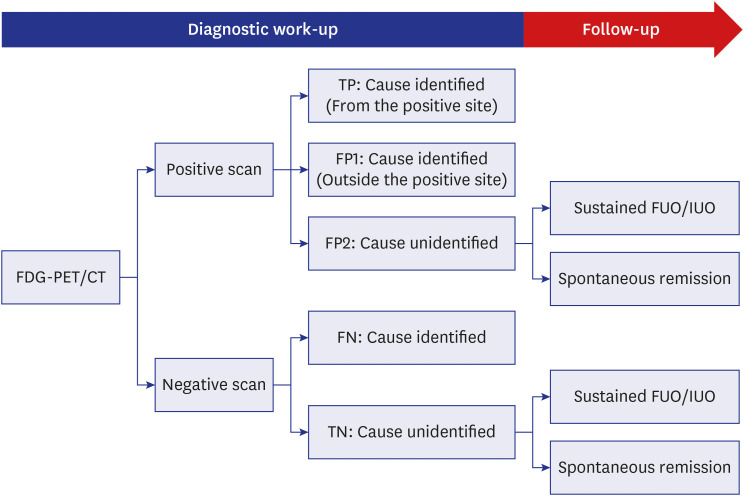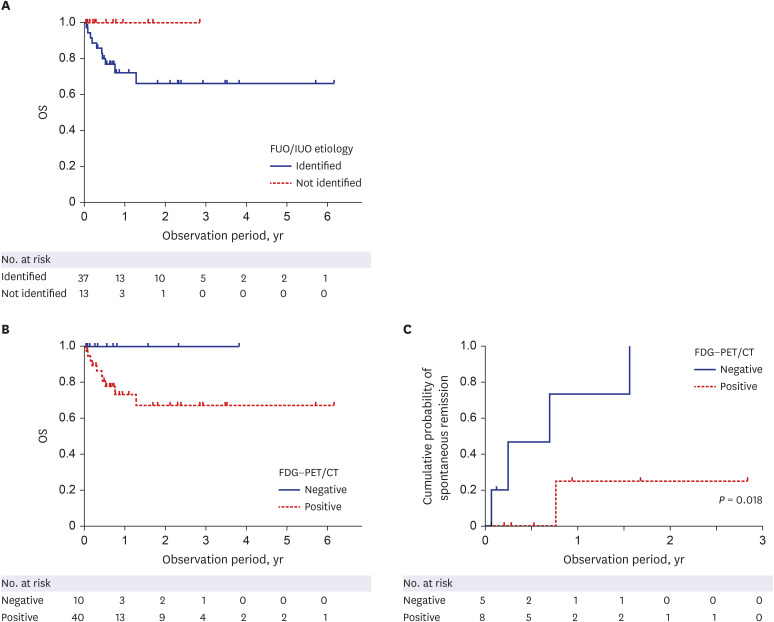J Korean Med Sci.
2021 Jun;36(22):e150. 10.3346/jkms.2021.36.e150.
Predictors of Diagnostic Contributions and Spontaneous Remission of Symptoms Associated with Positron Emission Tomography with Fluorine-18-Fluorodeoxy Glucose Combined with Computed Tomography in Classic Fever or Inflammation of Unknown Origin: a Retrospective Study
- Affiliations
-
- 1Department of Emergency and General Internal Medicine, Fujita Health University School of Medicine, Toyoake, Japan
- 2Department of Radiology, Fujita Health University School of Medicine, Toyoake, Japan
- KMID: 2516580
- DOI: http://doi.org/10.3346/jkms.2021.36.e150
Abstract
- Background
In patients with fever or inflammation of unknown origin (fever of unknown origin [FUO] or inflammation of unknown origin [IUO], respectively), expert consensus recommends the use of positron emission tomography with fluorine-18-fluorodeoxy glucose combined with computed tomography (FDG-PET/CT) when standard work-up fails to identify diagnostic clues. However, the clinical variables associated with successful localization of the cause by FDG-PET/CT remain uncertain. Moreover, the long-term outcomes of patients with unexplained FUO or IUO after negative FDG-PET/CT results are unknown. Therefore, we assessed predictors of successful diagnosis of FUO or IUO caused by FDG-PET/CT and associations of spontaneous remission of symptoms with FDG-PET/CT results.
Methods
All patients with FUO or IUO, who underwent FDG-PET/CT from 2013 to 2019 because diagnostic work-up failed to identify a cause, were retrospectively included. We calculated the diagnostic yield and performed multivariable logistic regression to assess characteristics previously proposed to be associated with successful localization of FUO or IUO causes. We also assessed whether the FDG-PET/CT results were associated with spontaneous remissions.
Results
In total, 50 patients with diagnostically challenging FUO or IUO (35 with FUO and 15 with IUO) were assessed. Other than one case of infection, all the identified causes were either malignancy or non-infectious inflammatory diseases (each with 18 patients), and FDG-PET/ CT correctly localized the cause in 29 patients (diagnostic yield = 58%). None of the proposed variables was associated with successful localization. All 13 patients with sustained unexplained cause remained alive (median follow-up, 190 days). Spontaneous remission was observed in 4 of 5 patients with a negative FDG-PET/CT, and 1 of 8 with a positive result (P = 0.018).
Conclusion
In the current cohort, the proposed variables were not predictive for successful localization by FDG-PET/CT. A negative FDG-PET/CT scan may be prognostic for spontaneous remission in patients with sustained FUO or IUO.
Keyword
Figure
Reference
-
1. Bleeker-Rovers CP, van der Meer JWM. Fever of unknown origin. In : Kasper DL, Hauser SL, Jameson JL, editors. Harrison's Principles of Internal Medicine. 19th ed. New York, NY, USA: McGraw-Hill;2015. p. 135–142.2. Vanderschueren S, Del Biondo E, Ruttens D, Van Boxelaer I, Wauters E, Knockaert DD. Inflammation of unknown origin versus fever of unknown origin: two of a kind. Eur J Intern Med. 2009; 20(4):415–418. PMID: 19524186.
Article3. Horowitz HW. Fever of unknown origin or fever of too many origins? N Engl J Med. 2013; 368(3):197–199. PMID: 23323894.
Article4. Takeuchi M, Dahabreh IJ, Nihashi T, Iwata M, Varghese GM, Terasawa T. Nuclear imaging for classic fever of unknown origin: meta-analysis. J Nucl Med. 2016; 57(12):1913–1919. PMID: 27339873.
Article5. Bharucha T, Rutherford A, Skeoch S, Alavi A, Brown M, Galloway J, et al. Diagnostic yield of FDG-PET/CT in fever of unknown origin: a systematic review, meta-analysis, and Delphi exercise. Clin Radiol. 2017; 72(9):764–771. PMID: 28600002.6. Schönau V, Vogel K, Englbrecht M, Wacker J, Schmidt D, Manger B, et al. The value of 18F-FDG-PET/CT in identifying the cause of fever of unknown origin (FUO) and inflammation of unknown origin (IUO): data from a prospective study. Ann Rheum Dis. 2018; 77(1):70–77. PMID: 28928271.7. Wang Q, Li YM, Li Y, Hua FC, Wang QS, Zhang XL, et al. 18F-FDGPET/CT in fever of unknown origin and inflammation of unknown origin: a Chinese multi-center study. Eur J Nucl Med Mol Imaging. 2019; 46(1):159–165. PMID: 30099578.8. Kubota K, Tanaka N, Miyata Y, Ohtsu H, Nakahara T, Sakamoto S, et al. Comparison of 18F-FDG PET/CT and 67Ga-SPECT for the diagnosis of fever of unknown origin: a multicenter prospective study in Japan. Ann Nucl Med. 2021; 35(1):31–46. PMID: 33037581.9. Kouijzer IJE, Mulders-Manders CM, Bleeker-Rovers CP, Oyen WJG. Fever of unknown origin: the value of FDG-PET/CT. Semin Nucl Med. 2018; 48(2):100–107. PMID: 29452615.
Article10. Kubota K, Takeuchi M, Wang Q, Nakamoto Y. FDG-PET/CT in patients with inflammation or fever of unknown origin (IUO and FUO). In : Toyama H, Li Y, Hatazawa J, Huang G, Kubota K, editors. PET/CT for Inflammatory Diseases. Berlin/Heidelberg, Germany: Springer;2020. p. 43–55.11. Li Y, Wang Q, Wang X, Li X, Wu H, Wang Q, et al. Expert consensus on clinical application of FDG PET/CT in infection and inflammation. Ann Nucl Med. 2020; 34(5):369–376. PMID: 32086761.
Article12. Crouzet J, Boudousq V, Lechiche C, Pouget JP, Kotzki PO, Collombier L, et al. Place of (18)F-FDG-PET with computed tomography in the diagnostic algorithm of patients with fever of unknown origin. Eur J Clin Microbiol Infect Dis. 2012; 31(8):1727–1733. PMID: 22735898.
Article13. Kim YJ, Kim SI, Hong KW, Kang MW. Diagnostic value of 18F-FDG PET/CT in patients with fever of unknown origin. Intern Med J. 2012; 42(7):834–837. PMID: 22805689.
Article14. Zheng YJ, Lv W, Pan QQ. Effect of 18F-FDG PET/CT on etiological diagnosis for fever of unknown origin (FUO). J Clin Oncol. 2013; 19(12):936–939.15. Gafter-Gvili A, Raibman S, Grossman A, Avni T, Paul M, Leibovici L, et al. [18F]FDG-PET/CT for the diagnosis of patients with fever of unknown origin. QJM. 2015; 108(4):289–298. PMID: 25208896.
Article16. Singh N, Kumar R, Malhotra A, Bhalla AS, Kumar U, Sood R. Diagnostic utility of fluorodeoxyglucose positron emission tomography/computed tomography in pyrexia of unknown origin. Indian J Nucl Med. 2015; 30(3):204–212. PMID: 26170562.
Article17. Takeuchi M, Nihashi T, Gafter-Gvili A, García-Gómez FJ, Andres E, Blockmans D, et al. Association of 18F-FDG PET or PET/CT results with spontaneous remission in classic fever of unknown origin: a systematic review and meta-analysis. Medicine (Baltimore). 2018; 97(43):e12909. PMID: 30412093.18. Tsuzuki S, Watanabe A, Iwata M, Toyama H, Terasawa T. Gallium citrate-67 single-photon emission computed tomography/computed tomography for localizing the foci of classic fever and inflammation of unknown origin: a retrospective study of diagnostic yield. Asia Ocean J Nucl Med Biol. 2021; 9(2):1–12. PMID: 33392343.19. Durack DT, Street AC. Fever of unknown origin--reexamined and redefined. Curr Clin Top Infect Dis. 1991; 11:35–51. PMID: 1651090.20. Robine A, Hot A, Maucort-Boulch D, Iwaz J, Broussolle C, Sève P. Fever of unknown origin in the 2000s: evaluation of 103 cases over eleven years. Presse Med. 2014; 43(9):e233–40. PMID: 24985921.
Article21. Boellaard R, Delgado-Bolton R, Oyen WJG, Giammarile F, Tatsch K, Eschner W, et al. FDG PET/CT: EANM procedure guidelines for tumour imaging: version 2.0. Eur J Nucl Med Mol Imaging. 2015; 42(2):328–354. PMID: 25452219.
Article22. Jamar F, Buscombe J, Chiti A, Christian PE, Delbeke D, Donohoe KJ, et al. EANM/SNMMI guideline for 18F-FDG use in inflammation and infection. J Nucl Med. 2013; 54(4):647–658. PMID: 23359660.23. Delbeke D, Coleman R, Guiberteau M, Brown M, Royal H, Siegel B, et al. Procedure guideline for tumor imaging with 18F-FDG PET/CT 1.0. J Nucl Med. 2006; 47(5):885–895. PMID: 16644760.24. Mulders-Manders CM, Engwerda C, Simon A, van der Meer JWM, Bleeker-Rovers CP. Long-term prognosis, treatment, and outcome of patients with fever of unknown origin in whom no diagnosis was made despite extensive investigation: a questionnaire based study. Medicine (Baltimore). 2018; 97(25):e11241. PMID: 29924054.25. Kouijzer IJE, van der Meer JWM, Oyen WJG, Bleeker-Rovers CP. Diagnostic yield of FDG-PET/CT in fever of unknown origin: a systematic review, meta-analysis, and Delphi exercise. Clin Radiol. 2018; 73(6):588–589. PMID: 29567271.
Article26. Morris TP, White IR, Carpenter JR, Stanworth SJ, Royston P. Combining fractional polynomial model building with multiple imputation. Stat Med. 2015; 34(25):3298–3317. PMID: 26095614.
Article27. Grant SW, Collins GS, Nashef SAM. Statistical primer: developing and validating a risk prediction model. Eur J Cardiothorac Surg. 2018; 54(2):203–208. PMID: 29741602.
Article28. White IR, Royston P, Wood AM. Multiple imputation using chained equations: issues and guidance for practice. Stat Med. 2011; 30(4):377–399. PMID: 21225900.
Article29. Austin PC, Steyerberg EW. Events per variable (EPV) and the relative performance of different strategies for estimating the out-of-sample validity of logistic regression models. Stat Methods Med Res. 2017; 26(2):796–808. PMID: 25411322.
Article30. Kang L, Xu XJ, Fan Y, Wang RF, Ma C, Fu ZL, et al. Diagnostic value of fluorine-18 fluorodeoxyglucose positron emission tomography/computed tomography in fever of unknown origin. Beijing Da Xue Xue Bao Yi Xue Ban. 2015; 47(1):175–180. PMID: 25686352.31. Fu LP, Hu P, Wang QS, Wu HB, Li LF. 18F-FDG PET/CT imaging for fever of unknown origin. Chin J Clin Infect Dis. 2010; 3(3):176–179.32. Fu N, Gong L. Analysis of the diagnostic value of 18F-FDG PET/CT in fever of unknown origin. Clinical Focus. 2013; 28(5):519–521.33. Kei PL, Kok TY, Padhy AK, Ng DC, Goh AS. [18F] FDG PET/CT in patients with fever of unknown origin: a local experience. Nucl Med Commun. 2010; 31(9):788–792. PMID: 20634769.
Article
- Full Text Links
- Actions
-
Cited
- CITED
-
- Close
- Share
- Similar articles
-
- Outcome in Patients with Fever of Unknown Origin whose ¹â¸Fluoro-Deoxyglucose Positron Emission Tomography/Computerized Tomography Finding is Non-Diagnostic
- A Case of Atypical Giant Cell Arteritis Presenting as a Fever of Unknown Origin
- 18F-2-Deoxy-2-Fluoro-D-Glucose Positron Emission Tomography: Computed Tomography for Preoperative Staging in Gastric Cancer Patients
- Mediastinal Tuberculous Lymphadenitis with Periodic Fever
- Fluorine-18 Fluorodeoxyglucose Positron Emission Tomography/Computed Tomography Findings of Post Traumatic Lymphangioma in a Young Adult Male



